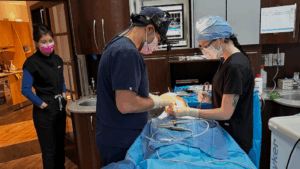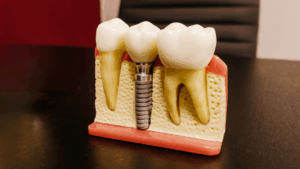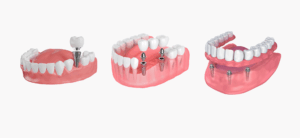Introduction
Tooth extractions are common procedures in oral and maxillofacial surgery clinics. Most of the time, healing proceeds smoothly after a tooth is removed. However, a painful and often under-recognized complication can occur: dry socket. This condition of the tooth socket arises when the protective blood clot is lost or does not form properly.
In this article, we explain what a dry socket is, how to recognize the symptoms of a dry socket, what to do in the event of an infection after a tooth extraction, the treatment options, and—above all—how to prevent these complications.

What Is Alveolitis?
A dry socket is a form of alveolar osteitis, or “dental alveolitis”: the socket (the small bony cavity that held the tooth) remains painful after extraction. There are two main types:
- Dry socket: absence or premature dissolution of the clot, leaving bone—and sometimes nerves—exposed. The pain is very sharp, often described as localized “bone pain.” In general, there is no pus or fever.
- Suppurative alveolitis (infectious alveolitis): pain accompanied by signs of infection, such as discharge (exudate), fever, and marked inflammation of the gums.
In short, it is an inflammation of the dental socket that can take several forms, including dry socket and suppurative alveolitis. “Alveolitis” thus encompasses different post-extraction inflammatory complications.
Location: the issue is located in the dental socket itself. Depending on the case, one or several sockets may be involved (for example, during the extraction of molars or wisdom teeth).
Causes of Dry Socket and Suppurative Alveolitis
Several factors can increase the risk of developing alveolitis:
- Premature loss of the clot
The formation of a blood clot is essential to protect the wound. If it is displaced or expelled, the bone is exposed, which causes pain. (See the FAQ below: “What does a dental blood clot look like?”) - Risky post-operative habits
Rinsing the mouth too vigorously, using a straw (suction), smoking, using an alcohol-based mouthwash too early, or consuming very hot foods and drinks after an extraction. Cigarette smoke in particular dries the mouth, reduces blood flow and slows healing, which increases the risk of developing a dry socket. - Complex extractions
Dry socket after wisdom tooth removal is more frequent, since the socket is deep, the back area is hard to keep clean, and the surgery may be more traumatic. - Other factors
Insufficient oral hygiene, inadequate hydration, resuming physical activities too quickly, or local trauma to the extraction site.

Dry Socket: Symptoms to Watch For
Dry socket usually appears 2 to 4 days after the extraction (often around 48–72 hours). The most frequent symptoms include:
- Severe pain that worsens instead of improving; it may radiate to the ear, jaw, temple or face. Intermittent painful episodes can also occur.
- Bad breath or an unpleasant taste in the mouth.
- A sensation of an “empty” socket; sometimes a white deposit is present after extraction (often fibrin or granulation tissue), without other signs of infection.
- Hypersensitivity when chewing on the operated side.
Dental Infection or Dry Socket? How to Tell the Difference
The fact that a dry socket develops does not automatically mean there is an infection.
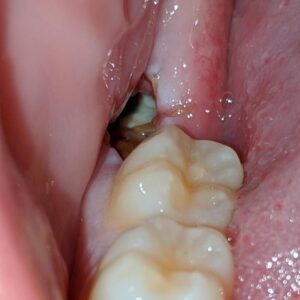
More likely a dry socket if:
- Very intense pain without fever or pus
- Painful socket with visible bone exposure
- Socket that appears empty or hollow
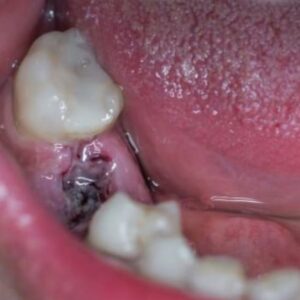
More likely an infection (suppurative alveolitis) if:
- Presence of pus
- Fever
- Significant, diffuse inflammation
- Swelling of the gums and cheek
- Throbbing pain
- Persistent bad odour
- Marked fatigue
- Uncontrollable pain
- Signs of infection
- Difficulty opening your mouth
- Recurrence of bleeding
- Numbness (possible nerve involvement)
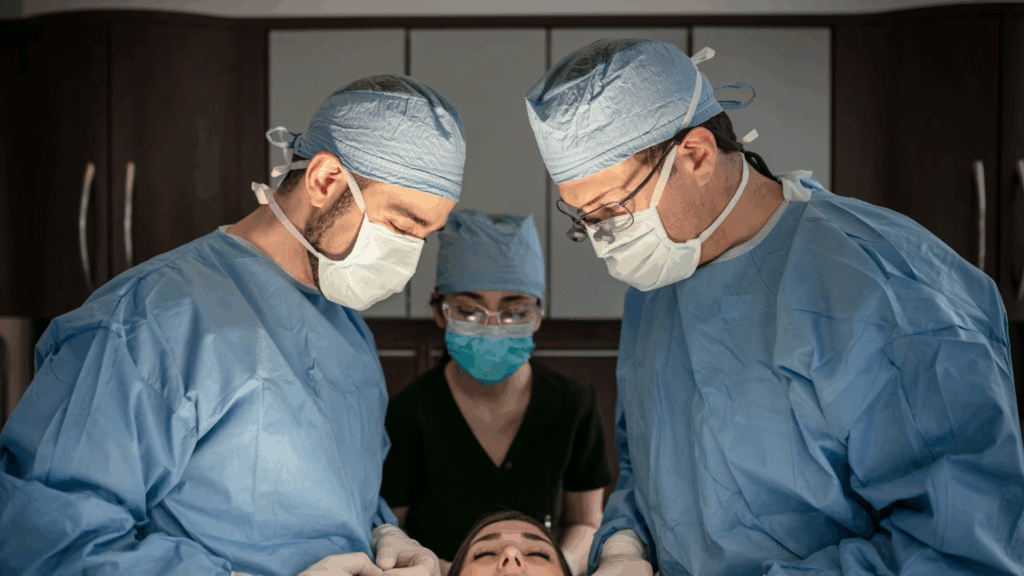
In Quebec, care is provided by an oral and maxillofacial surgeon, either in an oral surgery clinic or in a hospital setting.
Treatment of Dry Socket
Treatment of dry socket aims to relieve pain, protect the socket and promote healing.
- Assessment and gentle cleaning of the socket
- Soft irrigation to remove food debris and necrotic tissue without injuring exposed bone—generally with a saline solution to cleanse the cavity.
- Application of medicated intra-socket dressings
- Gauze strips containing topical anesthetics, antiseptics and eugenol (a clove-oil derivative) are used to protect the site and relieve pain. In some cases, a few drops of diluted clove essential oil may be applied locally to reduce discomfort, but only under professional supervision. These dressings can be replaced as needed over several days.
- Medication
- Analgesics or anti-inflammatories are prescribed as directed. Pain level is assessed and treatment adjusted using stepwise analgesic regimens (level 1, level 2).
- Antibiotics are prescribed only if a suppurative alveolitis is confirmed or if the surgeon indicates them based on the clinical situation.
- Close follow-up
- Monitoring of pain control, verification of healing, and personalized advice according to progress.
- Appropriate mouth rinses are recommended for post-operative oral hygiene to prevent secondary infection and promote healing.
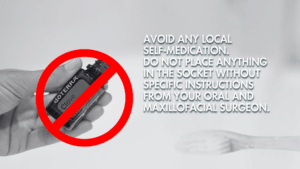
Preventing Dry Socket: Best Practices After Extraction
Objective: protect the clot and promote stable healing.
It is essential to follow post-surgical instructions carefully to reduce the risk of dry socket.
First 24 hours
- Do not rinse vigorously; let saliva drain naturally.
- Do not use a straw and avoid tobacco; no hot foods or drinks.
- Apply an ice pack according to the clinic’s protocol; rest.
24 to 48 hours
- Rinse gently with warm salt water, 2 to 3 times a day.
- Use an alcohol-free mouthwash only if prescribed by the surgeon.
- Brush the other teeth gently, avoiding the operated area.
After 72 hours
- Gradually resume eating habits; broaden your diet little by little.
- Maintain good oral hygiene to reduce bacterial load.
General precautions
- Follow the clinic’s written instructions closely.
- Stay well hydrated and choose foods that are soft and lukewarm.
- Avoid sports and strenuous physical effort for a few days.
What Does Normal Healing Look Like?
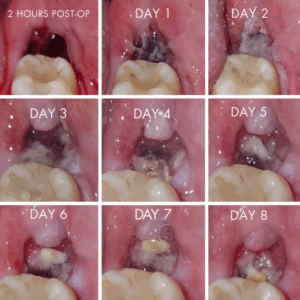
- A dark, stable clot fills the socket; its appearance changes gradually.
- Pain and swelling decrease progressively after 2–3 days.
- No fever or persistent unpleasant odour.
- A whitish deposit at the extraction site may correspond to fibrin (early granulation tissue): this is generally normal if pain is subsiding.
When to be concerned
- Pain that returns strongly a few days after extraction.
- Socket visibly empty, greyish site, discharge (exudate), fever: contact the clinic for reassessment.
Frequently Asked Questions About Dry Socket and Extractions
Can I brush my teeth normally after an extraction?
- Day 0–1: avoid the operated area; no alcohol-based mouthwash.
- From 24 hours: gentle brushing of the other teeth; light salt-water rinses.
- From 72 hours: gradual resumption around the site, according to comfort and your surgeon’s advice.
Which signs justify an urgent consultation?
- Suspected infection (pus, fever, swelling).
- Uncontrollable pain despite care and medication.
- Persistent bleeding, difficulty opening the mouth, numbness (possible nerve involvement).
 What does a dental blood clot look like?
What does a dental blood clot look like?
- It is dark, gelatinous, and fills the socket while gradually solidifying.
- In the case of dry socket, it is absent: bone may sometimes be visible at the bottom of the socket, accompanied by intense pain.
Is eugenol (clove oil) helpful?
- Yes, but only as dressings applied by the surgeon. Avoid applying clove oil yourself: it can irritate the wound and delay healing.
Is a dry socket automatically an “infection”?
- No. A dry socket is not necessarily infected. We speak of suppurative alveolitis only when there are signs of infection.
Quick Tips (Checklist)
- Protect the blood clot from day one.
- To prevent dry socket: avoid suction, tobacco, and alcohol-based mouthwashes too early.
- Post-op care: ice, rest, soft lukewarm foods.
- Follow-up scheduled with your oral and maxillofacial surgeon.
- Call the clinic if pain increases after the third day or if you suspect an infection.

Conclusion: Safely Restoring Oral Health
Dry socket is an uncomfortable complication, but it is usually well controlled when treated promptly by an oral surgery team. By following post-operative instructions, protecting the blood clot, and maintaining good oral hygiene, most cases progress favourably.
If you haven’t yet scheduled your treatment, book your tooth extraction with us today to ensure safe care and a smooth recovery.
Introduction
Tooth extractions are common procedures in oral and maxillofacial surgery clinics. Most of the time, healing proceeds smoothly after a tooth is removed. However, a painful and often under-recognized complication can occur: dry socket. This condition of the tooth socket arises when the protective blood clot is lost or does not form properly.
In this article, we explain what a dry socket is, how to recognize the symptoms of a dry socket, what to do in the event of an infection after a tooth extraction, the treatment options, and—above all—how to prevent these complications.

What Is Alveolitis?
A dry socket is a form of alveolar osteitis, or “dental alveolitis”: the socket (the small bony cavity that held the tooth) remains painful after extraction. There are two main types:
- Dry socket: absence or premature dissolution of the clot, leaving bone—and sometimes nerves—exposed. The pain is very sharp, often described as localized “bone pain.” In general, there is no pus or fever.
- Suppurative alveolitis (infectious alveolitis): pain accompanied by signs of infection, such as discharge (exudate), fever, and marked inflammation of the gums.
In short, it is an inflammation of the dental socket that can take several forms, including dry socket and suppurative alveolitis. “Alveolitis” thus encompasses different post-extraction inflammatory complications.
Location: the issue is located in the dental socket itself. Depending on the case, one or several sockets may be involved (for example, during the extraction of molars or wisdom teeth).
Causes of Dry Socket and Suppurative Alveolitis
Several factors can increase the risk of developing alveolitis:
- Premature loss of the clot
The formation of a blood clot is essential to protect the wound. If it is displaced or expelled, the bone is exposed, which causes pain. (See the FAQ below: “What does a dental blood clot look like?”) - Risky post-operative habits
Rinsing the mouth too vigorously, using a straw (suction), smoking, using an alcohol-based mouthwash too early, or consuming very hot foods and drinks after an extraction. Cigarette smoke in particular dries the mouth, reduces blood flow and slows healing, which increases the risk of developing a dry socket. - Complex extractions
Dry socket after wisdom tooth removal is more frequent, since the socket is deep, the back area is hard to keep clean, and the surgery may be more traumatic. - Other factors
Insufficient oral hygiene, inadequate hydration, resuming physical activities too quickly, or local trauma to the extraction site.

Dry Socket: Symptoms to Watch For
Dry socket usually appears 2 to 4 days after the extraction (often around 48–72 hours). The most frequent symptoms include:
- Severe pain that worsens instead of improving; it may radiate to the ear, jaw, temple or face. Intermittent painful episodes can also occur.
- Bad breath or an unpleasant taste in the mouth.
- A sensation of an “empty” socket; sometimes a white deposit is present after extraction (often fibrin or granulation tissue), without other signs of infection.
- Hypersensitivity when chewing on the operated side.
Dental Infection or Dry Socket? How to Tell the Difference
The fact that a dry socket develops does not automatically mean there is an infection.

More likely a dry socket if:
- Very intense pain without fever or pus
- Painful socket with visible bone exposure
- Socket that appears empty or hollow

More likely an infection (suppurative alveolitis) if:
- Presence of pus
- Fever
- Significant, diffuse inflammation
- Swelling of the gums and cheek
- Throbbing pain
- Persistent bad odour
- Marked fatigue
- Uncontrollable pain
- Signs of infection
- Difficulty opening your mouth
- Recurrence of bleeding
- Numbness (possible nerve involvement)

In Quebec, care is provided by an oral and maxillofacial surgeon, either in an oral surgery clinic or in a hospital setting.
Treatment of Dry Socket
Treatment of dry socket aims to relieve pain, protect the socket and promote healing.
- Assessment and gentle cleaning of the socket
-
- Soft irrigation to remove food debris and necrotic tissue without injuring exposed bone—generally with a saline solution to cleanse the cavity.
- Application of medicated intra-socket dressings
-
- Gauze strips containing topical anesthetics, antiseptics and eugenol (a clove-oil derivative) are used to protect the site and relieve pain. In some cases, a few drops of diluted clove essential oil may be applied locally to reduce discomfort, but only under professional supervision. These dressings can be replaced as needed over several days.
- Medication
-
- Analgesics or anti-inflammatories are prescribed as directed. Pain level is assessed and treatment adjusted using stepwise analgesic regimens (level 1, level 2).
- Antibiotics are prescribed only if a suppurative alveolitis is confirmed or if the surgeon indicates them based on the clinical situation.
- Close follow-up
- Monitoring of pain control, verification of healing, and personalized advice according to progress.
- Appropriate mouth rinses are recommended for post-operative oral hygiene to prevent secondary infection and promote healing.

Preventing Dry Socket: Best Practices After Extraction
Objective: protect the clot and promote stable healing.
It is essential to follow post-surgical instructions carefully to reduce the risk of dry socket.
First 24 hours
- Do not rinse vigorously; let saliva drain naturally.
- Do not use a straw and avoid tobacco; no hot foods or drinks.
- Apply an ice pack according to the clinic’s protocol; rest.
24 to 48 hours
- Rinse gently with warm salt water, 2 to 3 times a day.
- Use an alcohol-free mouthwash only if prescribed by the surgeon.
- Brush the other teeth gently, avoiding the operated area.
After 72 hours
- Gradually resume eating habits; broaden your diet little by little.
- Maintain good oral hygiene to reduce bacterial load.
General precautions
- Follow the clinic’s written instructions closely.
- Stay well hydrated and choose foods that are soft and lukewarm.
- Avoid sports and strenuous physical effort for a few days.
What Does Normal Healing Look Like?

- A dark, stable clot fills the socket; its appearance changes gradually.
- Pain and swelling decrease progressively after 2–3 days.
- No fever or persistent unpleasant odour.
- A whitish deposit at the extraction site may correspond to fibrin (early granulation tissue): this is generally normal if pain is subsiding.
When to be concerned
- Pain that returns strongly a few days after extraction.
- Socket visibly empty, greyish site, discharge (exudate), fever: contact the clinic for reassessment.
Frequently Asked Questions About Dry Socket and Extractions
Can I brush my teeth normally after an extraction?
- Day 0–1: avoid the operated area; no alcohol-based mouthwash.
- From 24 hours: gentle brushing of the other teeth; light salt-water rinses.
- From 72 hours: gradual resumption around the site, according to comfort and your surgeon’s advice.
Which signs justify an urgent consultation?
- Suspected infection (pus, fever, swelling).
- Uncontrollable pain despite care and medication.
- Persistent bleeding, difficulty opening the mouth, numbness (possible nerve involvement).
What does a dental blood clot look like?

- It is dark, gelatinous, and fills the socket while gradually solidifying.
- In the case of dry socket, it is absent: bone may sometimes be visible at the bottom of the socket, accompanied by intense pain.
Is eugenol (clove oil) helpful?
- Yes, but only as dressings applied by the surgeon. Avoid applying clove oil yourself: it can irritate the wound and delay healing.
Is a dry socket automatically an “infection”?
- No. A dry socket is not necessarily infected. We speak of suppurative alveolitis only when there are signs of infection.
Quick Tips (Checklist)
- Protect the blood clot from day one.
- To prevent dry socket: avoid suction, tobacco, and alcohol-based mouthwashes too early.
- Post-op care: ice, rest, soft lukewarm foods.
- Follow-up scheduled with your oral and maxillofacial surgeon.
- Call the clinic if pain increases after the third day or if you suspect an infection.

Conclusion: Safely Restoring Oral Health
Dry socket is an uncomfortable complication, but it is usually well controlled when treated promptly by an oral surgery team. By following post-operative instructions, protecting the blood clot, and maintaining good oral hygiene, most cases progress favourably.
If you haven’t yet scheduled your treatment, book your tooth extraction with us today to ensure safe care and a smooth recovery.






